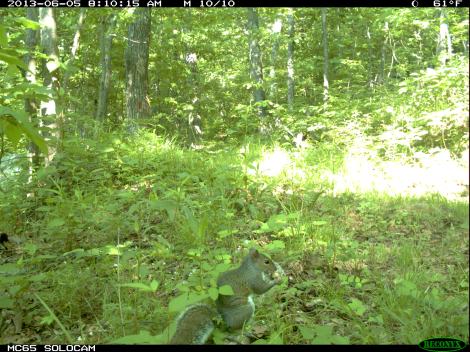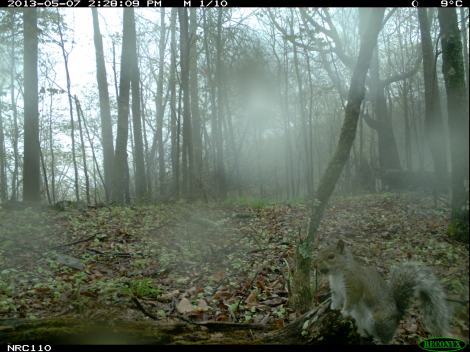Say the word “hoarding” to most people and it will conjure up images of reality TV about people who live surrounded by piles of junk. In ecology hoarding has a much different meaning, and refers to the practice of hiding food to be eaten later. Hoarding is a strategy to store seasonally abundant food to eat later in the year and to hide food from other animals. There are two kinds of hoarding, larder hoarding and scatter hoarding. Larder hoarding animals will make central food caches, or larders, that they vigorously defend. Scatter hoarders will create many different food caches, usually with a single food item. Many bird and mammal species cache their food, including the eastern gray squirrel (Sciurus carolinensis), the species that is also the second most commonly detected animal on eMammal cameras.
If you have watched a squirrel for any amount of time, it is quickly obvious that most of a squirrel’s life is spent chasing nuts. They risk life and limb to grab them off the spindly ends of branches far above the ground, they spend hours burying and re-burying them throughout the forest, and they brawl with other squirrels over access to the best trees. Squirrels eat the acorns of over 20 species of oaks, as well as hickory nuts, walnuts, beech nuts, hazelnuts, and any other kind of nut they can get their hands on and chew open. Squirrels also eat plants, insects, bird eggs, and even baby birds, but acorns and other nuts are their main food source.
Most small rodents hibernate through the winter, but hoarding helps squirrels stay active all winter long. Gray squirrels actually have a higher body temperature during the winter and eat up to twice as much food during low temperatures to keep themselves warm and active. Gray squirrels are scatter hoarders, and spend the summer burying acorns and other nuts in throughout their territory. Gray squirrels play the scatter hoarding game well, and will actually fake bury acorn in case other squirrels, or even birds like blue jays (Cyanocitta cristata), are watching to steal their nuts. They will also come back, dig a nut up and move it to a new location to make sure it is safe! Squirrels are also surprisingly sophisticated about choosing which food to cache. They will often choose to cache red oak acorns, which germinate in the spring but usually eat “white” oak acorns on the spot. White oaks will germinate in the fall and quickly lose their nutritional value if stored for long in the ground.
Scatter hoarding has profoundly affected the ecology of gray squirrels. Squirrels have evolved a detailed spatial memory, and recover about 40-80 percent of their hundreds of caches. Scattering individual nuts across the landscape means that recovering their food depends more on spatial memory than defending an area, and gray squirrels often have overlapping home ranges, share scent posts, and will even share winter nests with other squirrels of the same sex. By contrast red squirrels (Tamiasciurus douglasii) store all the nuts they gather in a central larder and are highly territorial.
The scatter hoarding of gray squirrels also plays an important role in forest regeneration, as scatter hoarding squirrels are essentially planting hundreds or thousands of nuts throughout the forest. All of the nuts that a squirrel forgets are ready to germinate into young trees in the spring. The work of the squirrels provides them food for the winter, makes them an often annoyingly frequent visitor to camera traps, and also spreads helps every nut bearing tree that bears nuts through the forest to grow in the spring and renew the forest.
Sources
Elbroch, Mark and Kurt Rinehart. Behavior of North American Mammals. New York: Houghton Mifflin, 2011. 374 pgs.
Koprowski, J. L. 1994. Sciurus carolinensis. Mammalian Species 480:1-9.
Steele, M., L.A. Wauters, and K.W. Larsen. “Selection, Predation, and Dispersal of Seeds by Tree Squirrels in Temperate and Boreal Forests: are Tree Squirrels Keystone Granivores?” Seed Fate: Predation, Dispersal, and Seedling Establishment. Oxfordshire: CABI Publishing, 2005. 450 pgs.



Pingback: Action Shots: Squirrels and Robins | fojap·
Watched those gray squirrels bury nuts all over the yard today, how do they get to them when there’s several feet of snow?
WHEN do they dig them out? I see my squirrels go hungry, as if they forgot they buried my nuts I gave them the day before!
I’m doing children’s story at church next week and your report helps me greatly! Thank you so much!!! Wish you had photos to go with though😊